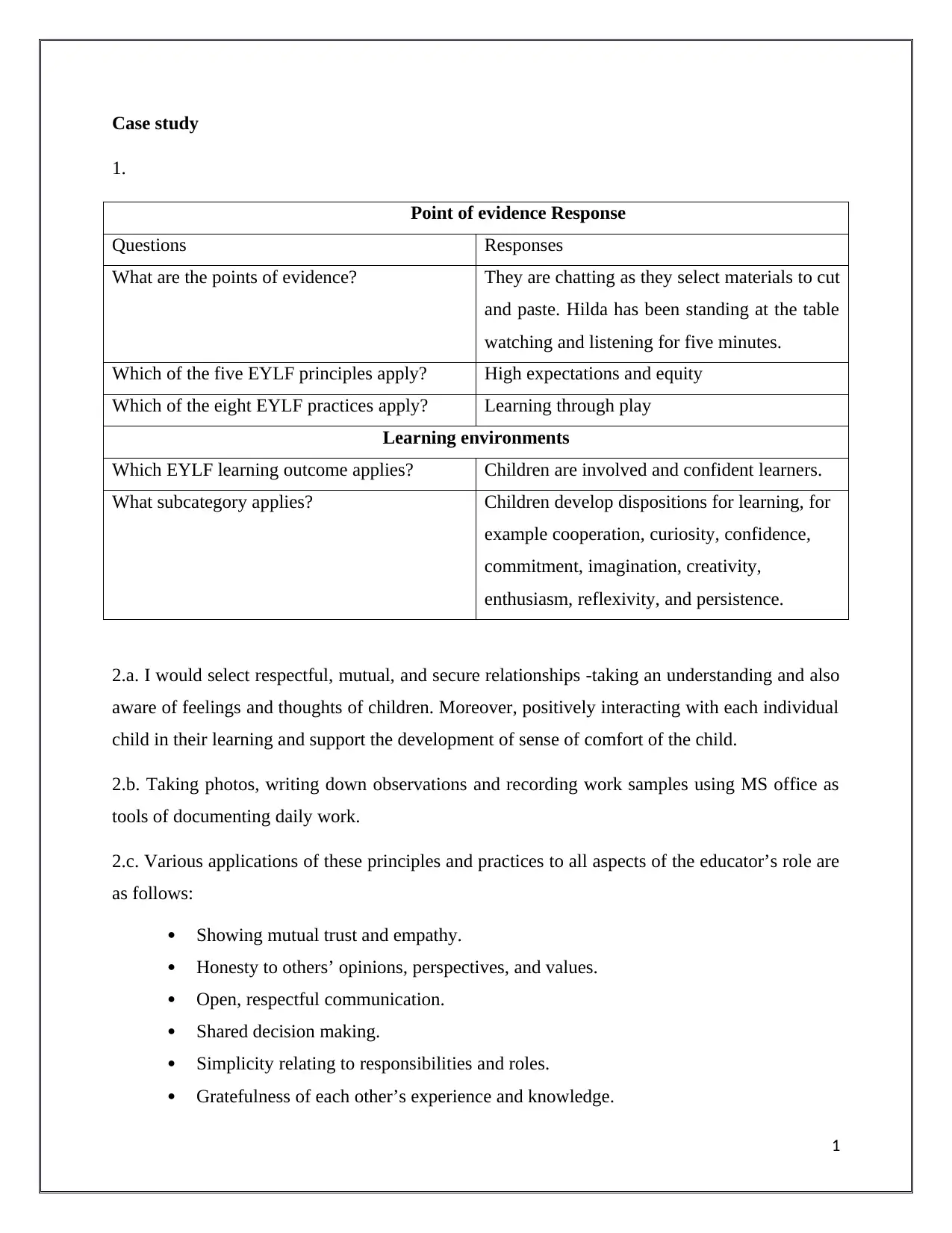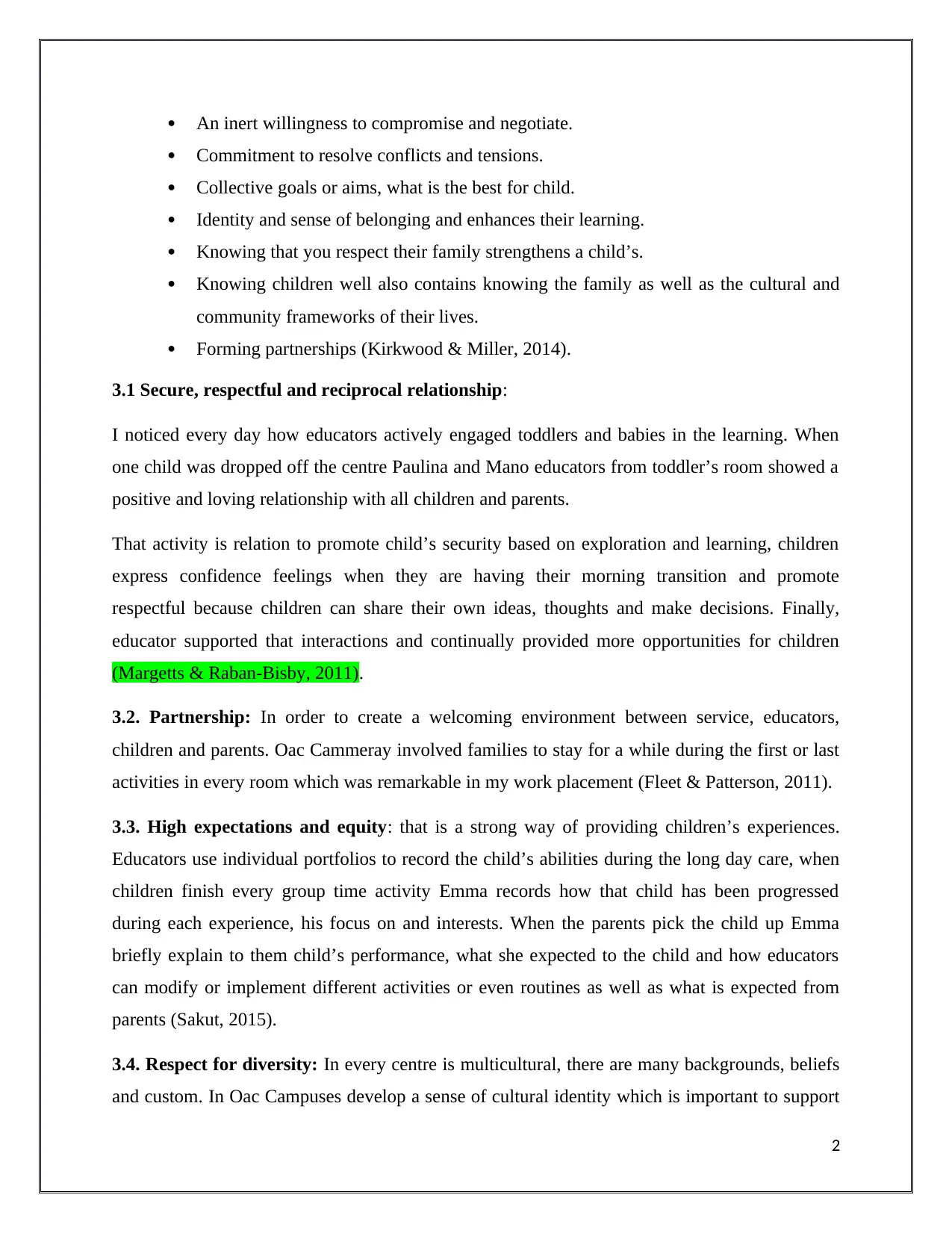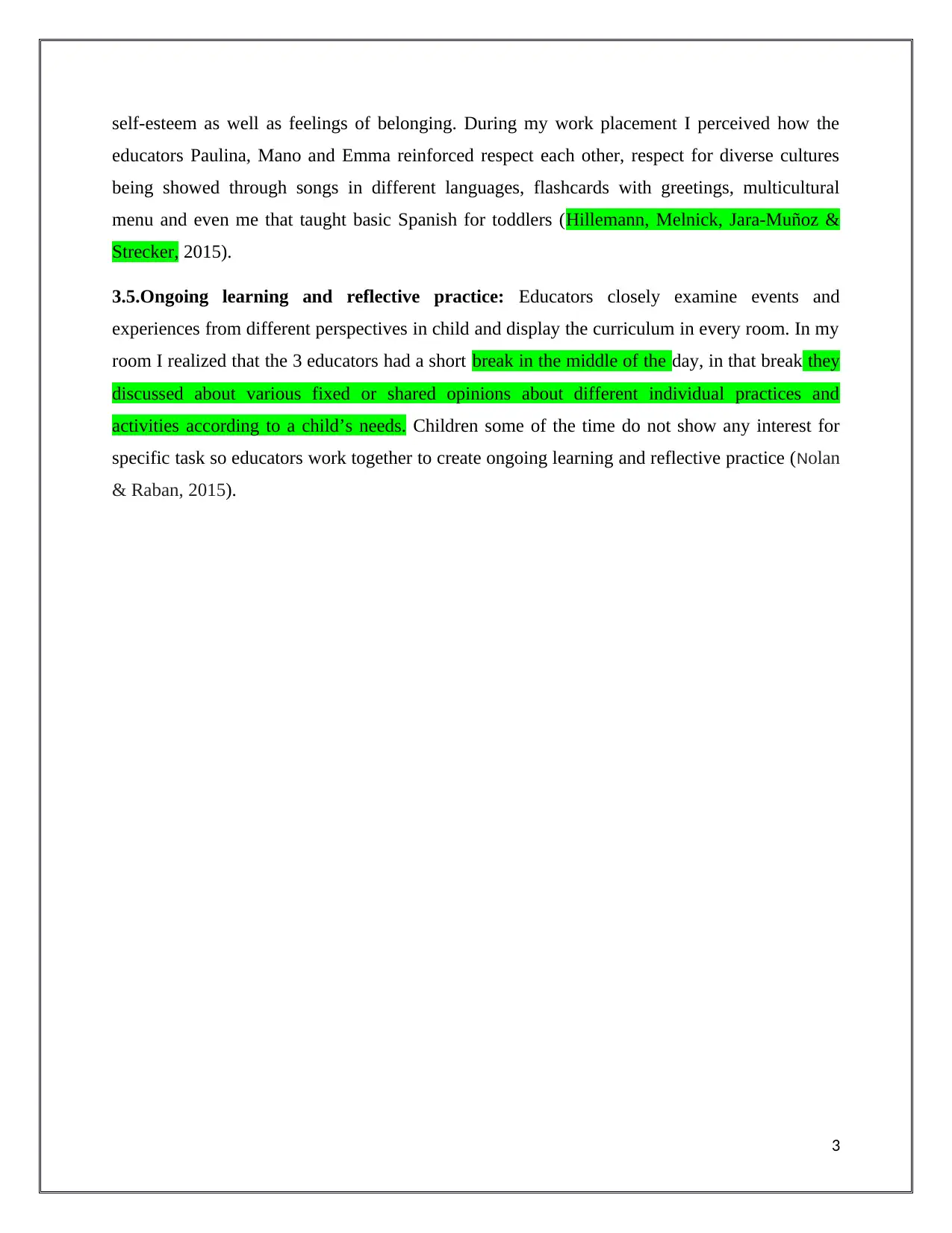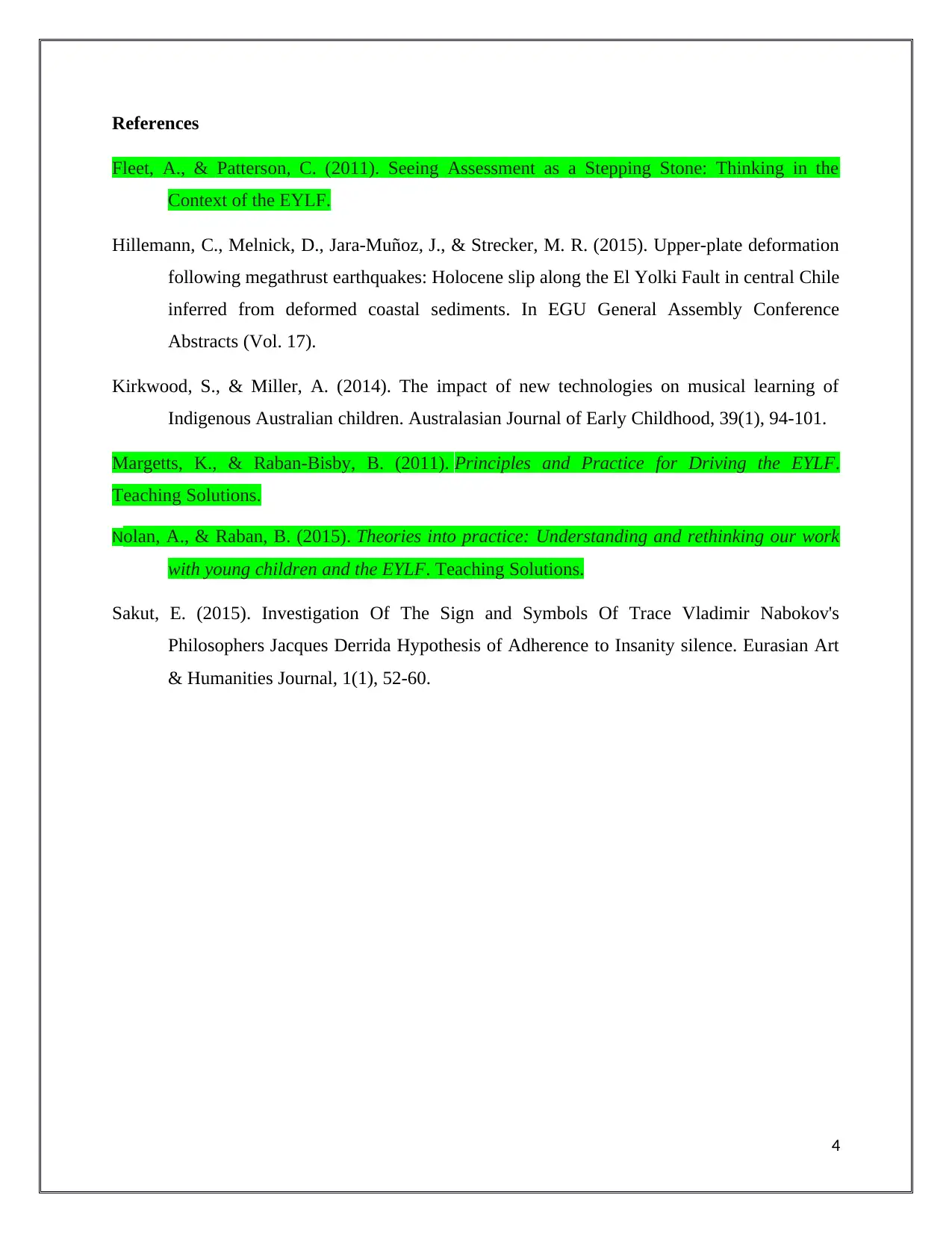Analysis of EYLF Principles in an Early Childhood Setting
VerifiedAdded on 2023/04/17
|4
|851
|138
Case Study
AI Summary
This case study analyzes the application of the Early Years Learning Framework (EYLF) principles and practices within an early childhood education setting. It examines a scenario involving children's interactions and educator responses, identifying the relevant EYLF principles such as high expectations and equity, and practices like learning through play and creating effective learning environments. The assignment explores how educators foster children's learning and development, focusing on aspects like respectful relationships, partnerships, and respect for diversity. Documentation methods like observations and portfolios are discussed. Furthermore, the case study highlights the importance of ongoing learning and reflective practice for educators in adapting to children's needs and creating a supportive learning environment. References include works on EYLF principles and their practical application in early childhood settings.

Case study
1.
Point of evidence Response
Questions Responses
What are the points of evidence? They are chatting as they select materials to cut
and paste. Hilda has been standing at the table
watching and listening for five minutes.
Which of the five EYLF principles apply? High expectations and equity
Which of the eight EYLF practices apply? Learning through play
Learning environments
Which EYLF learning outcome applies? Children are involved and confident learners.
What subcategory applies? Children develop dispositions for learning, for
example cooperation, curiosity, confidence,
commitment, imagination, creativity,
enthusiasm, reflexivity, and persistence.
2.a. I would select respectful, mutual, and secure relationships -taking an understanding and also
aware of feelings and thoughts of children. Moreover, positively interacting with each individual
child in their learning and support the development of sense of comfort of the child.
2.b. Taking photos, writing down observations and recording work samples using MS office as
tools of documenting daily work.
2.c. Various applications of these principles and practices to all aspects of the educator’s role are
as follows:
Showing mutual trust and empathy.
Honesty to others’ opinions, perspectives, and values.
Open, respectful communication.
Shared decision making.
Simplicity relating to responsibilities and roles.
Gratefulness of each other’s experience and knowledge.
1
1.
Point of evidence Response
Questions Responses
What are the points of evidence? They are chatting as they select materials to cut
and paste. Hilda has been standing at the table
watching and listening for five minutes.
Which of the five EYLF principles apply? High expectations and equity
Which of the eight EYLF practices apply? Learning through play
Learning environments
Which EYLF learning outcome applies? Children are involved and confident learners.
What subcategory applies? Children develop dispositions for learning, for
example cooperation, curiosity, confidence,
commitment, imagination, creativity,
enthusiasm, reflexivity, and persistence.
2.a. I would select respectful, mutual, and secure relationships -taking an understanding and also
aware of feelings and thoughts of children. Moreover, positively interacting with each individual
child in their learning and support the development of sense of comfort of the child.
2.b. Taking photos, writing down observations and recording work samples using MS office as
tools of documenting daily work.
2.c. Various applications of these principles and practices to all aspects of the educator’s role are
as follows:
Showing mutual trust and empathy.
Honesty to others’ opinions, perspectives, and values.
Open, respectful communication.
Shared decision making.
Simplicity relating to responsibilities and roles.
Gratefulness of each other’s experience and knowledge.
1
Paraphrase This Document
Need a fresh take? Get an instant paraphrase of this document with our AI Paraphraser

An inert willingness to compromise and negotiate.
Commitment to resolve conflicts and tensions.
Collective goals or aims, what is the best for child.
Identity and sense of belonging and enhances their learning.
Knowing that you respect their family strengthens a child’s.
Knowing children well also contains knowing the family as well as the cultural and
community frameworks of their lives.
Forming partnerships (Kirkwood & Miller, 2014).
3.1 Secure, respectful and reciprocal relationship:
I noticed every day how educators actively engaged toddlers and babies in the learning. When
one child was dropped off the centre Paulina and Mano educators from toddler’s room showed a
positive and loving relationship with all children and parents.
That activity is relation to promote child’s security based on exploration and learning, children
express confidence feelings when they are having their morning transition and promote
respectful because children can share their own ideas, thoughts and make decisions. Finally,
educator supported that interactions and continually provided more opportunities for children
(Margetts & Raban-Bisby, 2011).
3.2. Partnership: In order to create a welcoming environment between service, educators,
children and parents. Oac Cammeray involved families to stay for a while during the first or last
activities in every room which was remarkable in my work placement (Fleet & Patterson, 2011).
3.3. High expectations and equity: that is a strong way of providing children’s experiences.
Educators use individual portfolios to record the child’s abilities during the long day care, when
children finish every group time activity Emma records how that child has been progressed
during each experience, his focus on and interests. When the parents pick the child up Emma
briefly explain to them child’s performance, what she expected to the child and how educators
can modify or implement different activities or even routines as well as what is expected from
parents (Sakut, 2015).
3.4. Respect for diversity: In every centre is multicultural, there are many backgrounds, beliefs
and custom. In Oac Campuses develop a sense of cultural identity which is important to support
2
Commitment to resolve conflicts and tensions.
Collective goals or aims, what is the best for child.
Identity and sense of belonging and enhances their learning.
Knowing that you respect their family strengthens a child’s.
Knowing children well also contains knowing the family as well as the cultural and
community frameworks of their lives.
Forming partnerships (Kirkwood & Miller, 2014).
3.1 Secure, respectful and reciprocal relationship:
I noticed every day how educators actively engaged toddlers and babies in the learning. When
one child was dropped off the centre Paulina and Mano educators from toddler’s room showed a
positive and loving relationship with all children and parents.
That activity is relation to promote child’s security based on exploration and learning, children
express confidence feelings when they are having their morning transition and promote
respectful because children can share their own ideas, thoughts and make decisions. Finally,
educator supported that interactions and continually provided more opportunities for children
(Margetts & Raban-Bisby, 2011).
3.2. Partnership: In order to create a welcoming environment between service, educators,
children and parents. Oac Cammeray involved families to stay for a while during the first or last
activities in every room which was remarkable in my work placement (Fleet & Patterson, 2011).
3.3. High expectations and equity: that is a strong way of providing children’s experiences.
Educators use individual portfolios to record the child’s abilities during the long day care, when
children finish every group time activity Emma records how that child has been progressed
during each experience, his focus on and interests. When the parents pick the child up Emma
briefly explain to them child’s performance, what she expected to the child and how educators
can modify or implement different activities or even routines as well as what is expected from
parents (Sakut, 2015).
3.4. Respect for diversity: In every centre is multicultural, there are many backgrounds, beliefs
and custom. In Oac Campuses develop a sense of cultural identity which is important to support
2

self-esteem as well as feelings of belonging. During my work placement I perceived how the
educators Paulina, Mano and Emma reinforced respect each other, respect for diverse cultures
being showed through songs in different languages, flashcards with greetings, multicultural
menu and even me that taught basic Spanish for toddlers (Hillemann, Melnick, Jara-Muñoz &
Strecker, 2015).
3.5.Ongoing learning and reflective practice: Educators closely examine events and
experiences from different perspectives in child and display the curriculum in every room. In my
room I realized that the 3 educators had a short break in the middle of the day, in that break they
discussed about various fixed or shared opinions about different individual practices and
activities according to a child’s needs. Children some of the time do not show any interest for
specific task so educators work together to create ongoing learning and reflective practice (Nolan
& Raban, 2015).
3
educators Paulina, Mano and Emma reinforced respect each other, respect for diverse cultures
being showed through songs in different languages, flashcards with greetings, multicultural
menu and even me that taught basic Spanish for toddlers (Hillemann, Melnick, Jara-Muñoz &
Strecker, 2015).
3.5.Ongoing learning and reflective practice: Educators closely examine events and
experiences from different perspectives in child and display the curriculum in every room. In my
room I realized that the 3 educators had a short break in the middle of the day, in that break they
discussed about various fixed or shared opinions about different individual practices and
activities according to a child’s needs. Children some of the time do not show any interest for
specific task so educators work together to create ongoing learning and reflective practice (Nolan
& Raban, 2015).
3
⊘ This is a preview!⊘
Do you want full access?
Subscribe today to unlock all pages.

Trusted by 1+ million students worldwide

References
Fleet, A., & Patterson, C. (2011). Seeing Assessment as a Stepping Stone: Thinking in the
Context of the EYLF.
Hillemann, C., Melnick, D., Jara-Muñoz, J., & Strecker, M. R. (2015). Upper-plate deformation
following megathrust earthquakes: Holocene slip along the El Yolki Fault in central Chile
inferred from deformed coastal sediments. In EGU General Assembly Conference
Abstracts (Vol. 17).
Kirkwood, S., & Miller, A. (2014). The impact of new technologies on musical learning of
Indigenous Australian children. Australasian Journal of Early Childhood, 39(1), 94-101.
Margetts, K., & Raban-Bisby, B. (2011). Principles and Practice for Driving the EYLF.
Teaching Solutions.
Nolan, A., & Raban, B. (2015). Theories into practice: Understanding and rethinking our work
with young children and the EYLF. Teaching Solutions.
Sakut, E. (2015). Investigation Of The Sign and Symbols Of Trace Vladimir Nabokov's
Philosophers Jacques Derrida Hypothesis of Adherence to Insanity silence. Eurasian Art
& Humanities Journal, 1(1), 52-60.
4
Fleet, A., & Patterson, C. (2011). Seeing Assessment as a Stepping Stone: Thinking in the
Context of the EYLF.
Hillemann, C., Melnick, D., Jara-Muñoz, J., & Strecker, M. R. (2015). Upper-plate deformation
following megathrust earthquakes: Holocene slip along the El Yolki Fault in central Chile
inferred from deformed coastal sediments. In EGU General Assembly Conference
Abstracts (Vol. 17).
Kirkwood, S., & Miller, A. (2014). The impact of new technologies on musical learning of
Indigenous Australian children. Australasian Journal of Early Childhood, 39(1), 94-101.
Margetts, K., & Raban-Bisby, B. (2011). Principles and Practice for Driving the EYLF.
Teaching Solutions.
Nolan, A., & Raban, B. (2015). Theories into practice: Understanding and rethinking our work
with young children and the EYLF. Teaching Solutions.
Sakut, E. (2015). Investigation Of The Sign and Symbols Of Trace Vladimir Nabokov's
Philosophers Jacques Derrida Hypothesis of Adherence to Insanity silence. Eurasian Art
& Humanities Journal, 1(1), 52-60.
4
1 out of 4
Related Documents
Your All-in-One AI-Powered Toolkit for Academic Success.
+13062052269
info@desklib.com
Available 24*7 on WhatsApp / Email
![[object Object]](/_next/static/media/star-bottom.7253800d.svg)
Unlock your academic potential
Copyright © 2020–2025 A2Z Services. All Rights Reserved. Developed and managed by ZUCOL.





